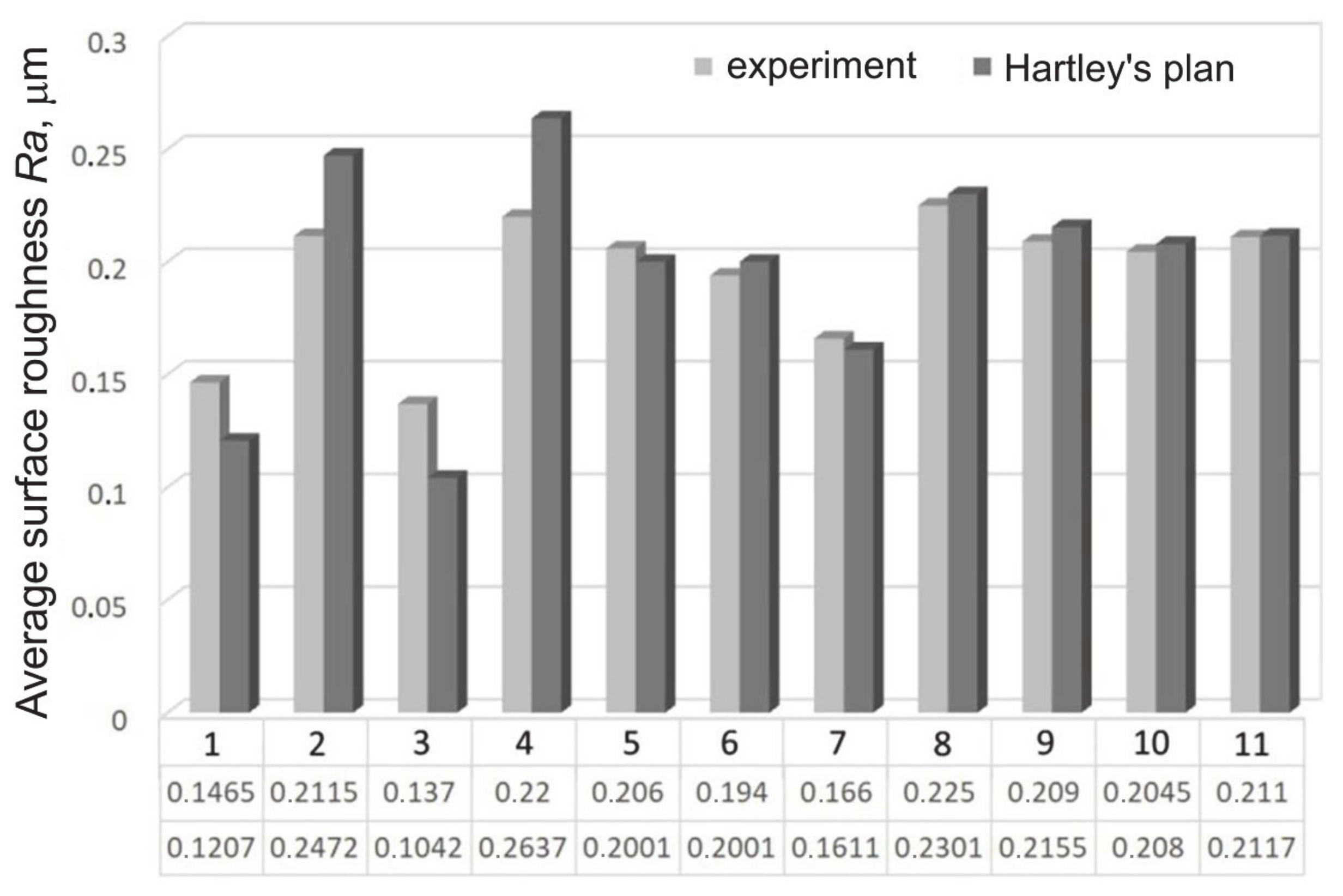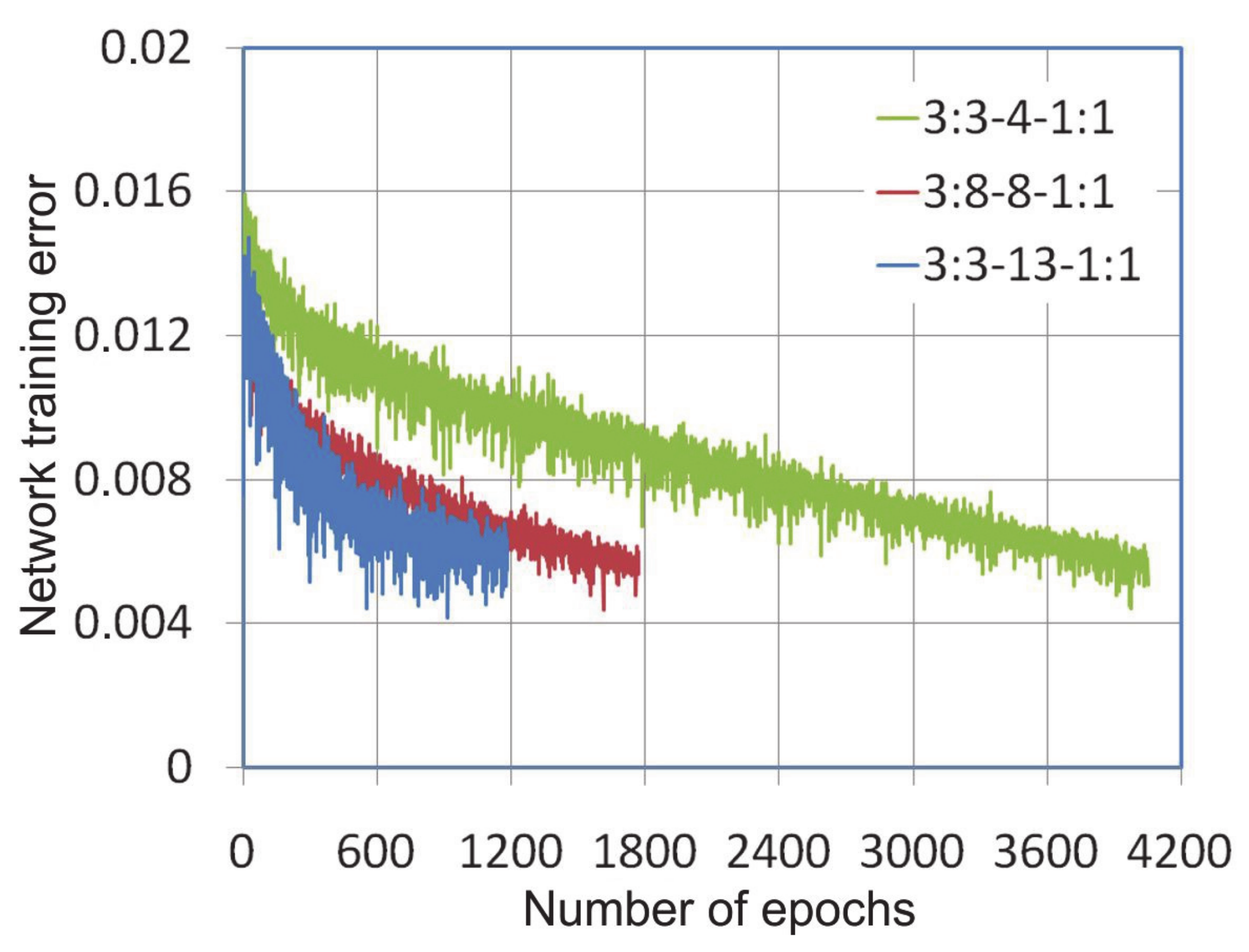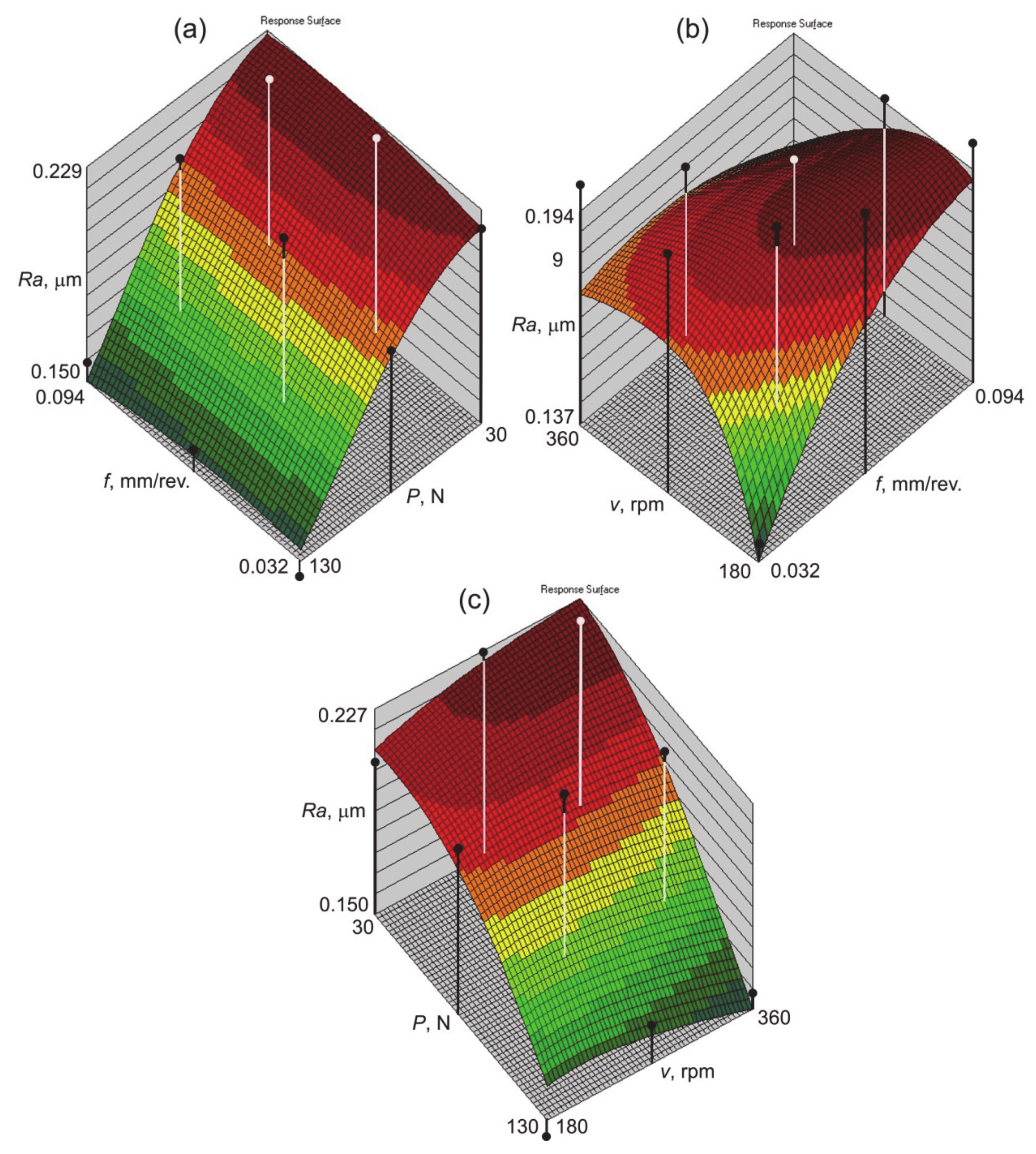Modelling the Influence of Slide Burnishing Parameters on the Surface Roughness of Shafts Made of 42CrMo4 Heat-Treatable Steel
Abstract
:1. Introduction
2. Material and Methods
2.1. Material
2.2. Methods
2.3. Modelling Using Artificial Neural Networks
- (a)
- root mean square error RMSE:
- (b)
- coefficient of determination R2:
- (c)
- mean absolute error MAE:
3. Results and Discussion
3.1. Hartley’s PS/DS-P:Ha3 Plan
3.2. ANN Modelling
4. Conclusions
Author Contributions
Funding
Institutional Review Board Statement
Informed Consent Statement
Data Availability Statement
Conflicts of Interest
References
- Korzynski, M.; Zarski, T. Slide diamond burnishing influence on of surface stereometric structure of an AZ91 alloy. Surf. Coat. Technol. 2016, 307, 590–595. [Google Scholar] [CrossRef]
- Dzierwa, A.; Gałda, L.; Tupaj, M.; Dudek, K. Investigation of wear resistance of selected materials after slide burnishing process. Eksploat. Niezawodn. Maint. Reliab. 2020, 22, 432–439. [Google Scholar] [CrossRef]
- Kumar, K.; Prasad, K.E. Application of roller burnishing process for final machining of cylindrical surface. IOSR J. Mech. Civ. Eng. 2016, 12, 1–7. [Google Scholar]
- Chomienne, V.; Valirgue, F.; Rech, J.; Vierdu, C. Influence of ball burnishing on residual stress profile of a 15-5PH stainless steel. CIRP J. Manuf. Sci. Technol. 2016, 13, 90–96. [Google Scholar] [CrossRef]
- Zaleski, K.; Skoczylas, A. Effect of slide burnishing on the surface layer and fatigue life of titanium alloy parts. Adv. Mater. Sci. 2019, 19, 35–45. [Google Scholar] [CrossRef] [Green Version]
- Labuda, W.; Starosta, R.; Charchalis, A. The analysis of the influence of the burnishing process on corrosion properties of steel applied to sea water pump shafts. J. Kones Powertrain Transp. 2011, 18, 221–228. [Google Scholar]
- Korzynski, M.; Lubas, J.; Swirad, S.; Dudek, K. Surface layer characteristics due to slide diamond burnishing with a cylindrical-ended tool. J. Mater. Proc. Technol. 2011, 211, 84–94. [Google Scholar] [CrossRef]
- Dzierwa, A.; Markopoulous, A.P. Influence of ball-burnishing process on surface topography parameters and tribological properties of hardened steel. Machines 2019, 7, 11. [Google Scholar] [CrossRef] [Green Version]
- Świrad, S. The surface texture analysis after sliding burnishing with cylindrical elements. Wear 2011, 271, 576–581. [Google Scholar] [CrossRef]
- Gharbi, F.; Sghaier, S.; Al-Fadhalah, K.J.; Benameur, T. Effect of ball burnishing process on the surface quality and microstructure properties of AISI 1010 steel plates. J. Mater. Eng. Perform. 2011, 20, 903–910. [Google Scholar] [CrossRef]
- Luo, H.; Liu, J.; Wang, L.; Zhong, Q. Investigation of the burnishing process with PCD tool on non-ferrous metals. Int. J. Adv. Manuf. Technol. 2005, 25, 454–459. [Google Scholar] [CrossRef]
- Shiou, F.J.; Cheng, C.H. Ultra-precision surface finish of NAK80 mould tool steel using sequential ball burnishing and ball polishing processes. J. Mater. Proc. Technol. 2008, 201, 554–559. [Google Scholar] [CrossRef]
- Maximov, J.T.; Duncheva, G.V.; Anchev, A.P.; Ganev, N.; Amudjev, I.M.; Dunchev, V.P. Effect of slide burnishing method on the surface integrity of AISI 316Ti chromium–nickel steel. J. Braz. Soc. Mech. Sci. Eng. 2018, 40, 194. [Google Scholar] [CrossRef]
- El-Tayeb, N.S.M.; Low, K.O.; Brevern, P.V. Influence of roller burnishing contact width and burnishing orientation on surface quality and tribological behaviour of aluminium 6061. J. Mater. Proc. Technol. 2007, 186, 272–278. [Google Scholar] [CrossRef]
- Silva-Álvarez, D.F.; Márquez-Herrera, A.; Saldaña-Robles, A.; Zapata-Torres, M.; Mis-Fernández, R.; Peña-Chapa, J.L.; Moreno-Palmerín, J.; Hernández-Rodríguez, E. Improving the surface integrity of the CoCrMo alloy by the ball burnishing technique. J. Mater. Res. Technol. 2020, 9, 7592–7601. [Google Scholar] [CrossRef]
- Maximov, J.T.; Duncheva, G.V.; Anchev, A.P.; Ichkova, M.D. Slide burnishing—review and prospects. Int. J. Adv. Manuf. Technol. 2019, 104, 785–801. [Google Scholar] [CrossRef]
- Low Plasticity Burnishing. Available online: https://www.lambdatechs.com/low-plasticity-burnishing-lpb/ (accessed on 18 February 2021).
- Avilés, R.; Albizuri, J.; Rodríguez, A.; López de Lacalle, L.N. Influence of low-plasticity ball burnishing on the high-cycle fatigue strength of medium carbon AISI 1045 steel. Int. J. Fatigue 2013, 55, 230–244. [Google Scholar] [CrossRef]
- Seemikeri, C.Y.; Brahmankar, P.K.; Mahagaonkar, S.B. Low plasticity burnishing: An innovative manufacturing method for biomedical applications. J. Manuf. Sci. Eng. 2008, 130, 021008. [Google Scholar] [CrossRef]
- Mohammadi, F.; Sedaghati, R.; Bonakdar, A. Finite element analysis and design optimization of low plasticity burnishing process. Int. J. Adv. Manuf. Technol. 2014, 70, 1337–1354. [Google Scholar] [CrossRef]
- Priyadarsini, C.; Ramana, V.S.N.V.; Prabha, K.A.; Swetha, S. A review on ball, roller, low plasticity burnishing process. Mater. Today: Proc. 2019, 18, 5087–5099. [Google Scholar] [CrossRef]
- Prevéy, P.S.; Jayaraman, N.; Overview of Low Plasticity Burnishing for Mitigation of Fatigue Damage Mechanisms. Fatigue and Fracture of Steels. Available online: https://www.shotpeener.com/library/pdf/2005096.pdf (accessed on 18 February 2021).
- Wang, G.; Zhao, Y.; Hao, Y. Friction stir welding of high-strength aerospace aluminum alloy and application in rocket tank manufacturing. J. Mater. Sci. Technol. 2017, 34, 73–91. [Google Scholar] [CrossRef]
- Sánchez Egea, A.J.; Rodríguez, A.; Celentano, D.; Calleja, A.; Lopez de Lacalle, L.N. Joining metrics enhancement when combining FSW and ball-burnishing in a2050 aluminium alloy. Surf. Coat. Technol. 2019, 367, 327–335. [Google Scholar] [CrossRef] [Green Version]
- Prevéy, S.; Jayarama, N.; Ravindranath, R.A.; Shepard, M. Improved high cycle fatigue damage tolerance of turbine engine compressor components by low plasticity burnishing (LPB). J. Eng. Gas Turbines Power 2008, 130, 012102. [Google Scholar] [CrossRef] [Green Version]
- López de Lacalle, L.N.; Lamikiz, A.; Sánchez, J.A.; Arana, J.L. The effect of ball burnishing on heat-treated steel and Inconel 718 milled surfaces. Int. J. Adv. Manuf. Technol. 2007, 32, 958–968. [Google Scholar] [CrossRef]
- López de Lacalle, L.N.; Lamikiz, A.; Muñoa, J.; Sanchez, J.A. Quality improvement of ball-end milled sculptured surfaces by ball burnishing. Int. J. Mach. Tools Manuf. 2005, 45, 1659–1668. [Google Scholar] [CrossRef]
- Przybylski, W. Low placticity burnishing processes. In Fundaments, Tools and Machine Tools; Publishing of the Institute for Sustainable Technologies: Radom, Poland, 2019. [Google Scholar]
- Kozłowski, E.; Mazurkiewicz, D.; Żabiński, T.; Prucnal, S.; Sęp, J. Assessment model of cutting tool condition for real-time supervision system. Eksploat. Niezawodn. Maint. Reliab. 2019, 21, 679–685. [Google Scholar] [CrossRef]
- Altaf, S.; Mehmood, M.S.; Imran, M. Implementation of efficient artificial neural network data fusion classification technique for induction motor fault detection. J. Eng. Sci. 2018, 5, E16–E21. [Google Scholar] [CrossRef]
- Rao, K.V.; Murthy, B.S.N.; Rao, M. Prediction of cutting tool wear, surface roughness and vibration of work piece in boring of AISI 316 steel with artificial neural network. Measurement 2014, 51, 63–70. [Google Scholar]
- Shinde, N.M.; Kurkuter, V.K. Optimization of single roller burnishing operation for surface roughness of aluminium alloy using artificial neural network. Int. J. Mech. Eng. 2015, 43, 1289–1293. [Google Scholar]
- Ugur, E.; Kulekci, M.K.; Ozgun, S.; Kazancoglu, Y. Predictive modelling of ball burnishing process using regression analysis and neural network. Mater. Testing 2013, 55, 187–192. [Google Scholar] [CrossRef]
- Esme, U. Use of grey based Taguchi method in ball burnishing process for the optimization of AA7075 aluminium alloy. Mater. Test. 2010, 44, 129–135. [Google Scholar]
- Ozgun, S. Use of artificial neural networks in ball burnishing process for the prediction of surface roughness of AA 7075 aluminium alloy. MSc Thesis, Mersin University, Mersin, Turkey, 2010. [Google Scholar]
- Sağbaş, A.; Kahraman, F. Prediction and Optimization of Surface Roughness in Ball Burnishing Process using Response Surface Methodology. J. Sci. Technol. 2009, 3, 140–148. [Google Scholar]
- Deshmukh, A.; Patil, R.N. Analysis and Optimization of Roller Burnishing Process on Cylindrical Surfacemicro Hardness of Aluminium Alloy. Int. J. Innov. Res. Sci. Eng. Technol. 2015, 4, 6044–6055. [Google Scholar]
- Cagan, S.C.; Pruncu, C.I.; Buldum, B.B. An investigation into ball burnishing process of magnesium alloy on CNC lathe using different environments. J. Magnes. Alloy. 2020, 8, 1061–1070. [Google Scholar] [CrossRef]
- Datta, S.; Bandyopadhyay, A.; Pal, P.K. Grey-based Taguchi method for optimization of bead geometry in submerged arc bead-on-plate welding. Int. J. Adv. Manuf. Technol. 2008, 39, 1136–1143. [Google Scholar] [CrossRef]
- El-Khabeery, M.M.; El-Axir, M.H. Experimental techniques for studying the effects of milling roller-burnishing parameters on surface integrity. Int. J. Mach. Tools Manuf. 2001, 41, 1705–1719. [Google Scholar] [CrossRef]
- Cagan, S.C.; Aci, M.; Buldum, B.B.; Aci, C. Artificial neural networks in mechanical surface enhancement technique for the prediction of surface roughness and microhardness of magnesium alloy. Bull.Polish Academy of Sci. Tec. Sci. 2019, 67, 729–739. [Google Scholar]
- Esme, U.; Sagbas, A.; Kahraman, F.; Kulekci, M.K. Use of artificial neural networks in ball burnishing process for the prediction of surface roughness of AA 7075 aluminium alloy. Mater. Technol. 2008, 42, 215–219. [Google Scholar]
- EN 10083-2:2006–Steels for quenching and tempering. Part 2: Technical delivery conditions for non alloy steels.
- EN ISO 4287:1999–Geometrical Product Specifications (GPS)—Surface Texture: Profile Method-Terms, Definitions and Surface Texture Parameters.
- Nalbant, M.; Gökkaya, H.; Toktaş, I.; Sur, G. The experimental investigation of the effects of uncoated, PVD- and CVD-coated cemented carbide inserts and cutting parameters on surface roughness in CNC turning and its prediction using artificial neural networks. Robot. Comput. Int. Manuf. 2009, 25, 211–223. [Google Scholar] [CrossRef]
- Marquardt, D. An algorithm for least squares estimation of non-linear parameters. J. Soc. Ind. Appl. Math. 1963, 11, 431–441. [Google Scholar] [CrossRef]
- Priddy, K.L.; Keller, P.E. Artificial Neural Networks An Introduction; Spie Press Book: Bellingham, WA, USA, 2005. [Google Scholar]
- Trzepieciński, T.; Lemu, H.G. Application of genetic algorithms to optimize neural networks for selected tribological tests. J. Mech. Eng. Autom. 2012, 2, 69–76. [Google Scholar]
- Shiou, F.J.; Huang, S.J.; Shih, A.J.; Zhu, J.; Yoshino, M. Fine surface finish of a hardened stainless steel using new burnishing tool. Procedia Manuf. 2017, 10, 208–217. [Google Scholar] [CrossRef]
- Bobrovskij, N.; Melnikov, P.; Grigoriev, S.; Bobrovskij, I. Aspects of thermal field by wide burnishing. IOP Conf. Ser. Mater. Sci. Eng. 2015, 91, 012035. [Google Scholar] [CrossRef] [Green Version]
- Ibrahim, A.A. An investigation into ball burnishing process of carbon steel on a lathe. In Proceedings of the Al-Azhar Engineering Tenth International Conference, Cairo, Egypt, 24–26 December 2008. [Google Scholar]
- Dzionk, S.; Scibiorski, B.; Przybylski, W. Surface texture analysis of hardened shafts after ceramic ball burnishing. Materials 2019, 12, 204. [Google Scholar] [CrossRef] [PubMed] [Green Version]
- Dyl, T.C.; Charchalis, A.; Stradomski, G.; Rydz, D. Impact of processing parameters on surface roughness and strain hardening of two-phase stainless steel. J. Kones Powertrain Transp. 2019, 26, 37–44. [Google Scholar] [CrossRef] [Green Version]
- Dwivedi, S.P.; Sharma, S.; Misra, R.K. Effects of roller burnishing process parameters on surface roughness of A356/5%SiC composite using response surface methodology. Adv. Manuf. 2014, 2, 303–317. [Google Scholar] [CrossRef] [Green Version]
- Nguyen, T.T.; Mia, M. Modeling and evaluation of energy efficiency of new hybrid turning-burnishing process in terms of surface properties. Energies 2020, 13, 4929. [Google Scholar] [CrossRef]






| Yield Stress Rp0.2, MPa | Ultimate Tensile Stress Rm, MPa | Elongation, % | Hardness HB | Toughness KV, J |
|---|---|---|---|---|
| 650 | 900–1100 | 12 | 265–325 | min. 35 at 20 °C |
| Number of Experiment | Feed Rate f, mm/rev. | Impact Force P, N | Burnishing Speed v, rpm |
|---|---|---|---|
| 1 | 0.094 | 130 | 360 |
| 2 | 0.094 | 30 | 180 |
| 3 | 0.032 | 130 | 180 |
| 4 | 0.032 | 30 | 360 |
| 5 | 0.094 | 80 | 270 |
| 6 | 0.032 | 80 | 270 |
| 7 | 0.063 | 130 | 270 |
| 8 | 0.063 | 30 | 270 |
| 9 | 0.063 | 80 | 360 |
| 10 | 0.063 | 80 | 180 |
| 11 | 0.063 | 80 | 270 |
| Experiment No. | Average Surface Roughness Ra | Error Variance | ||
|---|---|---|---|---|
| Measurement 1 | Measurement 2 | Mean | ||
| 1 | 0.145 | 0.148 | 0.1465 | 0.000045 |
| 2 | 0.216 | 0.207 | 0.2115 | 0.000405 |
| 3 | 0.143 | 0.131 | 0.137 | 0.00072 |
| 4 | 0.217 | 0.223 | 0.220 | 0.00018 |
| 5 | 0.205 | 0.207 | 0.206 | 0.00002 |
| 6 | 0.191 | 0.197 | 0.194 | 0.00018 |
| 7 | 0.169 | 0.163 | 0.166 | 0.00018 |
| 8 | 0.226 | 0.224 | 0.225 | 0.00002 |
| 9 | 0.216 | 0.202 | 0.209 | 0.00098 |
| 10 | 0.204 | 0.205 | 0.2045 | 0.000005 |
| 11 | 0.208 | 0.214 | 0.211 | 0.00018 |
| Experiment No. | Average Surface Roughness Ra | Error Variance | ||
|---|---|---|---|---|
| Measurement 1 | Measurement 2 | Mean | ||
| 1 | 0.209 | 0.202 | 0.2055 | 0.00002 |
| 2 | 0.271 | 0.258 | 0.2645 | 0.00008 |
| 3 | 0.0936 | 0.0914 | 0.0925 | 0.000002 |
| 4 | 0.156 | 0.153 | 0.1545 | 0.000005 |
| 5 | 0.217 | 0.190 | 0.2035 | 0.0004 |
| 6 | 0.107 | 0.114 | 0.1105 | 0.00002 |
| 7 | 0.110 | 0.0966 | 0.1033 | 0.00009 |
| 8 | 0.178 | 0.193 | 0.1855 | 0.0001 |
| 9 | 0.125 | 0.120 | 0.1225 | 0.00001 |
| 10 | 0.130 | 0.142 | 0.136 | 0.00007 |
| 11 | 0.133 | 0.143 | 0.138 | 0.00005 |
| Coefficient | |Value| | Relationship | Critical Value | Significance |
|---|---|---|---|---|
| bo | |2.117| | > | 0.0442 | significant |
| b1 | |0.0217| | < | 0.03271 | not significant |
| b2 | |−0.345| | > | 0.03271 | significant |
| b3 | |0.0375| | > | 0.03271 | significant |
| b11 | |−0.116118| | > | 0.051492 | significant |
| b22 | |−0.1611253| | > | 0.051492 | significant |
| b33 | |−0.04862| | < | 0.051492 | not significant |
| b12 | |0.045| | > | 0.04006 | significant |
| b13 | |−0.37| | > | 0.04006 | significant |
| b23 | |0.0025| | < | 0.04006 | not significant |
| Coefficient | |Value| | Relationship | Critical Value | Significance |
|---|---|---|---|---|
| bo | |0.1296| | > | 0.007454849 | significant |
| b1 | |0.0527| | > | 0.0527 | significant |
| b2 | |−0.03387| | > | 0.0527 | significant |
| b3 | |−0.00175| | < | 0.0527 | not significant |
| b11 | |0.029725| | > | 0.008684493 | significant |
| b22 | |0.01712| | > | 0.008684493 | significant |
| b33 | |0.00196901| | < | 0.008684493 | not significant |
| b12 | |0.00075| | < | 0.006756254 | not significant |
| b13 | |−0.03025| | > | 0.006756254 | significant |
| b23 | |0.05575| | > | 0.006756254 | significant |
| Network | Training Algorithm | Training Set | Verification Set | R2 | ||
|---|---|---|---|---|---|---|
| RMSE | MAE | RMSE | MAE | |||
| 3:3-4-1:1 | BP | 0.02316 | 0.01388 | 0.04760 | 0.03942 | 0.7896 |
| qN | 0.02091 | 0.02091 | 0.00737 | 0.00607 | 0.8704 | |
| LM | 0.02682 | 0.01827 | 0.01007 | 0.00910 | 0.7898 | |
| 3:3-8-1:1 | BP | 0.01456 | 0.01259 | 0.01446 | 0.01313 | 0.9661 |
| qN | 0.00305 | 0.00250 | 0.00303 | 0.00260 | 0.9971 | |
| LM | 0.00607 | 0.00505 | 0.00357 | 0.00254 | 0.9876 | |
| 3:3-13-1:1 | BP | 0.02855 | 0.01966 | 0.00247 | 0.00228 | 0.8946 |
| qN | 0.02612 | 0.01855 | 0.00200 | 0.00189 | 0.8826 | |
| LM | 0.02806 | 0.01992 | 0.00316 | 0.00282 | 0.7505 | |
| Experiment No. | Average Surface Roughness Ra, μm | Error | |
|---|---|---|---|
| Experiment | ANN 3:3-8-1:1 | ||
| 1 | 0.1465 | 0.168572 | 0.022072 |
| 3 | 0.137 | 0.159752 | 0.022752 |
| 4 | 0.22 | 0.233345 | 0.013345 |
| 5 | 0.206 | 0.218104 | 0.012104 |
| 6 | 0.194 | 0.213618 | 0.019618 |
| 7 | 0.166 | 0.165331 | −0.00067 |
| 9 | 0.209 | 0.220224 | 0.011224 |
| 10 | 0.2045 | 0.210982 | 0.006482 |
| 11 | 0.211 | 0.216063 | 0.005063 |
Publisher’s Note: MDPI stays neutral with regard to jurisdictional claims in published maps and institutional affiliations. |
© 2021 by the authors. Licensee MDPI, Basel, Switzerland. This article is an open access article distributed under the terms and conditions of the Creative Commons Attribution (CC BY) license (http://creativecommons.org/licenses/by/4.0/).
Share and Cite
Kluz, R.; Antosz, K.; Trzepieciński, T.; Bucior, M. Modelling the Influence of Slide Burnishing Parameters on the Surface Roughness of Shafts Made of 42CrMo4 Heat-Treatable Steel. Materials 2021, 14, 1175. https://doi.org/10.3390/ma14051175
Kluz R, Antosz K, Trzepieciński T, Bucior M. Modelling the Influence of Slide Burnishing Parameters on the Surface Roughness of Shafts Made of 42CrMo4 Heat-Treatable Steel. Materials. 2021; 14(5):1175. https://doi.org/10.3390/ma14051175
Chicago/Turabian StyleKluz, Rafał, Katarzyna Antosz, Tomasz Trzepieciński, and Magdalena Bucior. 2021. "Modelling the Influence of Slide Burnishing Parameters on the Surface Roughness of Shafts Made of 42CrMo4 Heat-Treatable Steel" Materials 14, no. 5: 1175. https://doi.org/10.3390/ma14051175
APA StyleKluz, R., Antosz, K., Trzepieciński, T., & Bucior, M. (2021). Modelling the Influence of Slide Burnishing Parameters on the Surface Roughness of Shafts Made of 42CrMo4 Heat-Treatable Steel. Materials, 14(5), 1175. https://doi.org/10.3390/ma14051175








